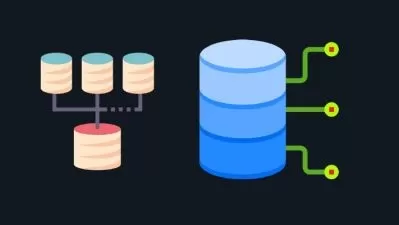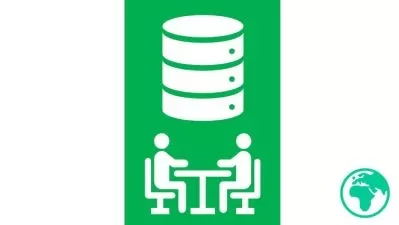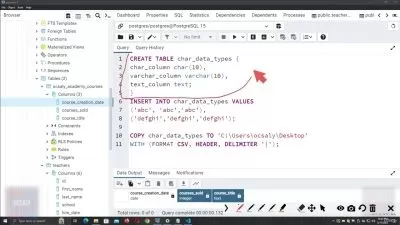[NEW] Oracle PL/SQL - An Ultimate Bootcamp (2023)
Lokanath Giri
19:38:08
Description
Become an Expert in PL/SQL | Latest Version of PL/SQL on Oracle 21c | All script files attached | Published: 16.09.2023
What You'll Learn?
- Anonymous Block
- Control Structure
- Error handling
- Cursors
- Procedure, Function
- Triggers
- Packages
- Dynamic SQL
- Collections
- PL/SQL Compiler
- Dependencies
- Pipeline Functions
- Handling LOBs
- Security
- Performance Tuning
- Bulk Collect
- Caching
- Best Practices
- Real life Examples
- Lots of coding Practice
- Latest version of PL/SQL on Oracle 21c
- Course by Professionals for Professionals
- Instructor has 10+ years real time experience in PL/SQL
Who is this for?
What You Need to Know?
More details
DescriptionOracle PL/SQL Training Syllabus
Introduction to PL/SQL
PL/SQL Overview
Benefits of PL/SQL Subprograms
Overview of the Types of PL/SQL blocks
Create a Simple Anonymous Block
Generate Output from a PL/SQL Block
PL/SQL Identifiers
List the different Types of Identifiers in a PL/SQL subprogram.
Usage of the Declarative Section to define Identifiers.
Use variables to store data.
Identify Scalar Data Types
The %TYPE Attribute
What are Bind Variables?
Sequences in PL/SQL Expressions
Write Executable Statements
Describe Basic PL/SQL Block Syntax Guidelines
Comment Code
Deployment of SQL Functions in PL/SQL
How to convert Data Types?
Nested Blocks
Identify the Operators in PL/SQL
Interaction with the Oracle Server
Invoke SELECT Statements in PL/SQL to Retrieve data.
Data Manipulation in the Server Using PL/SQL
SQL Cursor concept
Usage of SQL Cursor Attributes to Obtain Feedback on DML
Save and Discard Transactions
Control Structures
Conditional processing Using IF Statements
Conditional processing Using CASE Statements
Use simple Loop Statement
Use While Loop Statement
Use For Loop Statement
Describe the Continue Statement
Explicit Cursors
What are Explicit Cursors?
Declare the Cursor
Open the Cursor
Fetch data from the Cursor
Close the Cursor
Cursor FOR loop
Explicit Cursor Attributes
FOR UPDATE Clause and WHERE CURRENT Clause
Exception Handling
Understand Exceptions
Handle Exceptions with PL/SQL
Trap Predefined Oracle Server Errors
Trap Non-Predefined Oracle Server Errors
Trap User-Defined Exceptions
Propagate Exceptions
RAISE_APPLICATION_ERROR Procedure
Stored Procedures and Functions
Understand Stored Procedures and Functions
Differentiate between anonymous blocks and subprograms.
Create a Simple Procedure
Create a Simple Procedure with IN parameter.
Create a Simple Function
Execute a Simple Procedure
Execute a Simple Function
Create Stored Procedures
Create a Modularized and Layered Subprogram Design
Modularize Development With PL/SQL Blocks
Describe the PL/SQL Execution Environment
Identity the benefits of Using PL/SQL Subprograms
List the differences Between Anonymous Blocks and Subprograms
Create, Call, and Remove Stored Procedures Using the CREATE Command and SQL Developer
Implement Procedures Parameters and Parameters Modes
View Procedures Information Using the Data Dictionary Views and SQL Developer
Create Stored Functions
Create, Call, and Remove a Stored Function Using the CREATE Command and SQL Developer
Identity the advantages of Using Stored Functions in SQL Statements
List the steps to create a stored function.
Implement User-Defined Functions in SQL Statements
Identity the restrictions when calling Functions from SQL statements.
Control Side Effects when calling Functions from SQL Expressions
View Functions Information
Create Packages
Identity the advantages of Packages
Describe Packages
List the components of a Package.
Develop a Package
How to enable visibility of a Package's components?
Create the Package Specification and Body Using the SQL CREATE Statement and SQL Developer
Invoke Package Constructs
View PL/SQL Source Code Using the Data Dictionary
Implement Oracle-Supplied Packages in Application Development
What is Oracle-Supplied Packages?
Examples of Some of the Oracle-Supplied Packages
How Does the DBMS_OUTPUT Package Work?
Use the UTL_FILE Package to Interact With Operating System Files
Invoke the UTL_MAIL Package
Write UTL_MAIL Subprograms
Triggers
Describe Triggers
Identify the Trigger Event Types and Body
Business Application Scenarios for Implementing Triggers
Create DML Triggers Using the CREATE TRIGGER Statement and SQL Developer
Identify the Trigger Event Types, Body, and Firing (Timing)
Statement Level Triggers Versus Row Level Triggers
Create Instead of and Disabled Triggers
How to Manage, Test, and Remove Triggers?
Create Compound, DDL, and Event Database Triggers
What are Compound Triggers?
Identify the Timing-Point Sections of a Table Compound Trigger
Compound Trigger Structure for Tables and Views
Implement a Compound Trigger to Resolve the Mutating Table Error
Compare Database Triggers to Stored Procedures
Create Triggers on DDL Statements
Create Database-Event and System-Event Triggers
System Privileges Required to Manage Triggers
Composite Data Types - Collections
Use PL/SQL Records
The %ROWTYPE Attribute
Insert and Update with PL/SQL Records
Associative Arrays (INDEX BY Tables)
Examine INDEX BY Table Methods
Use INDEX BY Table of Records
Dynamic SQL
The Execution Flow of SQL
What is Dynamic SQL?
Declare Cursor Variables
Dynamically executing a PL/SQL Block
Configure Native Dynamic SQL to Compile PL/SQL Code
Invoke DBMS_SQL Package
Implement DBMS_SQL with a Parameterized DML Statement
Dynamic SQL Functional Completeness
PL/SQL Advanced
Packages
Overloading Subprograms in PL/SQL
Use Forward Declarations to Solve illegal Procedure Reference
Persistent State of Packages Variables
Persistent State of a Package Cursor
Manage Dependencies
Overview of Schema Object Dependencies
Query Direct Object Dependencies using the USER_DEPENDENCIES View
Query an Object's Status
Invalidation of Dependent Objects
Display the Direct and Indirect Dependencies
Understand Remote Dependencies
Recompile a PL/SQL Program Unit
Pipeline functions
What are pipeline functions?
Create is pipeline functions.
Check PGA memory consumption pipeline functions.
Error handling pipeline functions
The Trainer is an Architect with over 19+ years of experience, he has spent 10+ years working with PL/SQL
An Oracle Certified Professions (OCP)
Oracle Technology Network (OTN) Points: 12,975 Level: Master
Who this course is for:
- Database Developers
- Data Analysts
- ETL Developers
- Database Administrators
- Application Designers
- QA Professional to write stored procedures for data validations.
- DBA - Database Administrator For Automating Jobs and Securitiy Implemetation
- Anybody Interested to Learn PL/SQL Programming Language
- Anybody looking for Advanced PL/SQL concepts.
- Brand New Course Published on 16th Sep 2023
Oracle PL/SQL Training Syllabus
Introduction to PL/SQL
PL/SQL Overview
Benefits of PL/SQL Subprograms
Overview of the Types of PL/SQL blocks
Create a Simple Anonymous Block
Generate Output from a PL/SQL Block
PL/SQL Identifiers
List the different Types of Identifiers in a PL/SQL subprogram.
Usage of the Declarative Section to define Identifiers.
Use variables to store data.
Identify Scalar Data Types
The %TYPE Attribute
What are Bind Variables?
Sequences in PL/SQL Expressions
Write Executable Statements
Describe Basic PL/SQL Block Syntax Guidelines
Comment Code
Deployment of SQL Functions in PL/SQL
How to convert Data Types?
Nested Blocks
Identify the Operators in PL/SQL
Interaction with the Oracle Server
Invoke SELECT Statements in PL/SQL to Retrieve data.
Data Manipulation in the Server Using PL/SQL
SQL Cursor concept
Usage of SQL Cursor Attributes to Obtain Feedback on DML
Save and Discard Transactions
Control Structures
Conditional processing Using IF Statements
Conditional processing Using CASE Statements
Use simple Loop Statement
Use While Loop Statement
Use For Loop Statement
Describe the Continue Statement
Explicit Cursors
What are Explicit Cursors?
Declare the Cursor
Open the Cursor
Fetch data from the Cursor
Close the Cursor
Cursor FOR loop
Explicit Cursor Attributes
FOR UPDATE Clause and WHERE CURRENT Clause
Exception Handling
Understand Exceptions
Handle Exceptions with PL/SQL
Trap Predefined Oracle Server Errors
Trap Non-Predefined Oracle Server Errors
Trap User-Defined Exceptions
Propagate Exceptions
RAISE_APPLICATION_ERROR Procedure
Stored Procedures and Functions
Understand Stored Procedures and Functions
Differentiate between anonymous blocks and subprograms.
Create a Simple Procedure
Create a Simple Procedure with IN parameter.
Create a Simple Function
Execute a Simple Procedure
Execute a Simple Function
Create Stored Procedures
Create a Modularized and Layered Subprogram Design
Modularize Development With PL/SQL Blocks
Describe the PL/SQL Execution Environment
Identity the benefits of Using PL/SQL Subprograms
List the differences Between Anonymous Blocks and Subprograms
Create, Call, and Remove Stored Procedures Using the CREATE Command and SQL Developer
Implement Procedures Parameters and Parameters Modes
View Procedures Information Using the Data Dictionary Views and SQL Developer
Create Stored Functions
Create, Call, and Remove a Stored Function Using the CREATE Command and SQL Developer
Identity the advantages of Using Stored Functions in SQL Statements
List the steps to create a stored function.
Implement User-Defined Functions in SQL Statements
Identity the restrictions when calling Functions from SQL statements.
Control Side Effects when calling Functions from SQL Expressions
View Functions Information
Create Packages
Identity the advantages of Packages
Describe Packages
List the components of a Package.
Develop a Package
How to enable visibility of a Package's components?
Create the Package Specification and Body Using the SQL CREATE Statement and SQL Developer
Invoke Package Constructs
View PL/SQL Source Code Using the Data Dictionary
Implement Oracle-Supplied Packages in Application Development
What is Oracle-Supplied Packages?
Examples of Some of the Oracle-Supplied Packages
How Does the DBMS_OUTPUT Package Work?
Use the UTL_FILE Package to Interact With Operating System Files
Invoke the UTL_MAIL Package
Write UTL_MAIL Subprograms
Triggers
Describe Triggers
Identify the Trigger Event Types and Body
Business Application Scenarios for Implementing Triggers
Create DML Triggers Using the CREATE TRIGGER Statement and SQL Developer
Identify the Trigger Event Types, Body, and Firing (Timing)
Statement Level Triggers Versus Row Level Triggers
Create Instead of and Disabled Triggers
How to Manage, Test, and Remove Triggers?
Create Compound, DDL, and Event Database Triggers
What are Compound Triggers?
Identify the Timing-Point Sections of a Table Compound Trigger
Compound Trigger Structure for Tables and Views
Implement a Compound Trigger to Resolve the Mutating Table Error
Compare Database Triggers to Stored Procedures
Create Triggers on DDL Statements
Create Database-Event and System-Event Triggers
System Privileges Required to Manage Triggers
Composite Data Types - Collections
Use PL/SQL Records
The %ROWTYPE Attribute
Insert and Update with PL/SQL Records
Associative Arrays (INDEX BY Tables)
Examine INDEX BY Table Methods
Use INDEX BY Table of Records
Dynamic SQL
The Execution Flow of SQL
What is Dynamic SQL?
Declare Cursor Variables
Dynamically executing a PL/SQL Block
Configure Native Dynamic SQL to Compile PL/SQL Code
Invoke DBMS_SQL Package
Implement DBMS_SQL with a Parameterized DML Statement
Dynamic SQL Functional Completeness
PL/SQL Advanced
Packages
Overloading Subprograms in PL/SQL
Use Forward Declarations to Solve illegal Procedure Reference
Persistent State of Packages Variables
Persistent State of a Package Cursor
Manage Dependencies
Overview of Schema Object Dependencies
Query Direct Object Dependencies using the USER_DEPENDENCIES View
Query an Object's Status
Invalidation of Dependent Objects
Display the Direct and Indirect Dependencies
Understand Remote Dependencies
Recompile a PL/SQL Program Unit
Pipeline functions
What are pipeline functions?
Create is pipeline functions.
Check PGA memory consumption pipeline functions.
Error handling pipeline functions
The Trainer is an Architect with over 19+ years of experience, he has spent 10+ years working with PL/SQL
An Oracle Certified Professions (OCP)
Oracle Technology Network (OTN) Points: 12,975 Level: Master
Who this course is for:
- Database Developers
- Data Analysts
- ETL Developers
- Database Administrators
- Application Designers
- QA Professional to write stored procedures for data validations.
- DBA - Database Administrator For Automating Jobs and Securitiy Implemetation
- Anybody Interested to Learn PL/SQL Programming Language
- Anybody looking for Advanced PL/SQL concepts.
- Brand New Course Published on 16th Sep 2023
User Reviews
Rating
Lokanath Giri
Instructor's Courses
Udemy
View courses Udemy- language english
- Training sessions 180
- duration 19:38:08
- Release Date 2023/11/21










